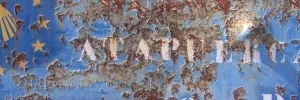Here you leave La Rioja behind and enter into Castilla y León, the largest of Spain’s autonomous communities. It is comprised of nine provinces, of which you have just entered Burgos. Along the Camino Francés, you will also pass through Palencia and León before leaving Castilla y León. The other 6 provinces (Salamanca, Zamora, Valladolid, Avila, Segovia, and Soria) are all part of one camino or another as they cross central Spain.
Just like La Rioja, you will continue to pass through villages with less than a two hundred (often less than one hundred) residents.
Burgos also marks the start of the Meseta, Spain’s central plateau and the breadbasket of the peninsula. The average elevation here is close to 800m and the weather can vary drastically from hot days to bone-chilling nights.
While the next 300km have a reputation for being flat and boring they are anything but.
It is here, at elevation and with wide open skies that the camino begins to work on your mind.
Redecilla is the first town in Castilla y León along the Camino Francés and was an important stop along the way during the 12th century, when two pilgrim hospices cared for pilgrims. One of them, San Lázaro, lends its name to the municipal albergue.
The gem of Redecilla is the Romanesque baptismal font in the Iglesia de Nuestra Señora de la Calle.
There is a tourist information office here, remarkable given the size of the town but easily explained by its location.
San Roque is celebrated on the 16th of August.
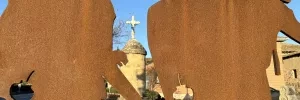
Small town with little more than a church, an ermita, and a truck stop restaurant with a reputation for serving up some decent hot chocolate. The only albergue in town is also the first house you come to, and the hospitaleros are wonderful.
The town gets its name from the born-here Francisco Delgado López, before that it was known as Villa de Pun. Francisco served as the Bishop of both Jaén and Lugo and was one of the most respected Counter-Reformation theologians at the Council of Trent.
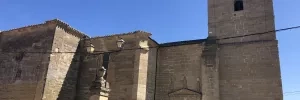
This sleepy agricultural town is best known for being the cuña (birthplace) of Santo Domingo de la Calzada. History did not see fit to preserve his house but the font in which he was baptized remains in the church.
Sandwiches and beverages are available at the Parada Viloria albergue.
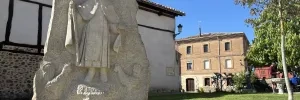
Do not let the grandiose name of the village fool you, neither the town nor the river is remarkable.
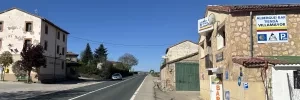
Belorado manages to maintain some of its advantages, but hard times have certainly taken their toll. A walk around the perimeter streets will reveal a quickly crumbling infrastructure. On the hillside sit the remains of a castle.
Several churches remain and the hospices have been replaced by many modern albergues. The main square is a nice place to hide from the sun if you fancy a rest.
There are many restaurants in the main square, and another (one of the better option for dinner) at the Cuatro Cantones albergue.
The Iglesia de Santa María has an altarpiece which depicts Santiago both as a Pilgrim and as a Moorslayer.
After a long string of nearly abandoned villages, Belorado is something of a wonder. Once again we have geography to thank; Belorado sits right in the middle of a narrow pass that cuts through two hillsides. The difference in altitude is small, less than 200m, but the hills are steep enough to provide some protection and fighting advantage. It was well developed before the arrival of Santo Domingo with his knack for setting towns on an east-west axis. At one time, the town boasted 8 churches, a thriving market, and 2 pilgrim hospices.
Also of note are the caves that dot the hillside here. They drew a not insignificant number of hermits to the area, many of which became well known. Santo Domingo chose a life of hermitage when he was turned away from the monastery, and other orders like that of St. Millán also began with a single cave-dwelling hermit.
The Fiesta of San Vitores is held on the 26th of August, and Thanksgiving is held on the first weekend in September. La Virgen de Belén is celebrated on the 25th of January.
Accommodation in Belorado.
| Albergue de Peregrinos Cuatro Cantones 12-16€ 65 Booking.com |
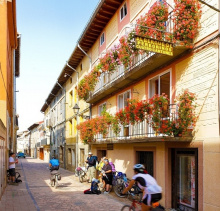
|
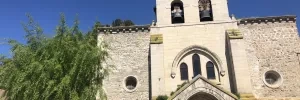
In recent years, the diminutive Tosantos has grown up a bit and now has a bar. The albergue parroquial is somewhat unique and maintains a tradition of communal meals and singalongs.
The nearby Ermita de la Peña, built into the cliffs, is a must see. A statue of Jesus as a child was hidden there for protection during the 9th century. It now spends half the year in the ermita and the other half in the Iglesia de San Esteban. Ask there for the key. If you stay in the albergue here, the hospitalero will likely offer a guided visit.
Accommodation in Tosantos.
| Albergue Parroquial San Francisco de Asís Donativo€ 30 |
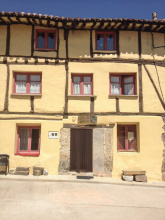
|
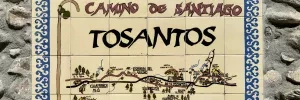
Accommodation in Villambistia.
| Albergue de San Roque 14€ 12 |
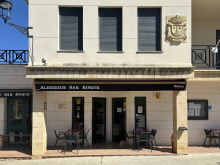
|
Espinosa has seen better days. Even with centuries of passing pilgrims it struggles to stay on the map. In recent years, a few buildings have been rehabilitated into an albergue and a bar.
Accommodation in Espinosa del Camino.
| Casa Las Almas 12€ 5 |
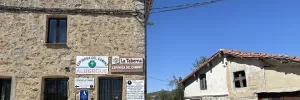
To the right of the main road when entering are a pair of bars that serve food to a mix of pilgrims and long road truck drivers, the Meson Alba being the most authentic dive of the two. The bustle of the road can make Villafranca feel a bit cramped, to escape that head to the Albergue San Anton Abad where the large garden and bar/restauran will quickly take your mind to a better place.
From Villafranca, there are 12km of camino without a water supply.
San Antón is celebrated on the 17th of January, and a Romería to the Ermita de Oca is held on the second Sunday of August.
Villafranca Montes de Oca, named for the nettle-filled mountains to the west, sits at the foot of the Pedraja pass. If you have become accustomed to the gently rolling hills behind you, brace yourself for a climb. Between here and San Juan de Ortega lay 12km of fountain-less hiking. It is however a beautiful forest full of flowers, views, and endemic oak trees.
There are no shops in San Juan, but there are now two bars that serve food. Pack accordingly. To follow the camino, turn right uphill towards the church.
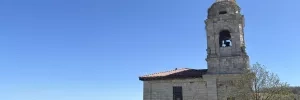
Picnic tables for a rest.
En route to the alto you will encounter a monument dedicated to a group of men from Burgos whose bodies were dumped here after their execution during the Civil War.
The path here intersects with several ATV trails. It is well marked but still requires some attention. Like the river crossings in Navarra, the low scrubland that surrounds you here was a popular place for bandits to lay in wait.
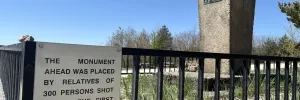
The monastery has been partially rehabilitated into an albergue for pilgrims, and it is here that pilgrims were served garlic soup by the monks; a tradition that continued up to recent times. If you have never spent the night in a room full of pilgrims that have eaten garlic soup for dinner, you have not lived.
The church has been restored and is a popular place for weddings. Twice a year (the 20th of March and the 23rd of September, both equinoxes) at around 5pm, light shines through one of the windows to illuminate one of the capitals, moving from the Anunciation to the birth of Christ.
This is one of the notable cases where the first bar is the better of the two; it is newer and appears to have won the hearts of most pilgrims.
Ignore the information board when leaving San Juan de Ortega. It is incorrect and may trick you into taking the wrong road to Castañares. Continue straight along the camino that heads back into the forest.
Contrary to popular belief, the village is not the birthplace of San Juan, he was born 20km away in the town of Quintanaortuño (north of Burgos). He was the disciple of Santo Domingo, and together they built many of the roads and bridges between here and Nájera. He earned the name Ortega, which derives from nettle, by building a hospice here and another in the forests between here and Villafranca.
His dedication to pilgrims en route to Santiago is a direct result of his own pilgrimage to the Holy Land. During his return journey, his ship was wrecked, and a promise was made by Juan to San Nicolas de Bari (himself a benevolent Bishop in Turkey and the model for present day Santa Claus). Juan would, in exchange for safety, devote himself to pilgrims. Back on dry land, he chose these mountains as his base; they were notoriously dangerous at the time, being both confusing to navigate and thick with thieves.
The hospice he built here grew to be a full monastery and attracted the attention of nobility, which placed it under the protection of nearby the Catedral de Burgos. Neglected for centuries, it is now undergoing a remarkable restoration and accurate replicas of the intricate stonework can be viewed up close.
The communities surrounding San Juan holds a romería (a small pilgrimage) to the church every 2nd of June.
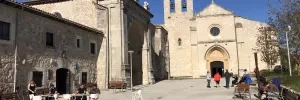
A pleasant but small town with a quirky mix of albergues. There are a number of restaurants in town that offer meals throughout the day.
Just outside of town, on your left-hand side and likely obscured by tall grass, sits one of San Juan de Ortega’s smaller engineering feats. It only takes one span to cross the diminutive río Vena.
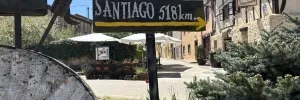
For the better part of the last 3 decades excavations have been underway to learn more about our prehistory. In the caves outside of town, the remains of early humans have been discovered; some as old as 800,000 years. Most of the discoveries have been transferred to the Museum of Human Evolution in Burgos.
Atapuerca, its prolific prehistoric discoveries aside, remains a small outpost. It was here where King Garcia of Nájera-Pamplona lost his life in a battle against his brother Ferdinand I of León on September 1st, 1054. The large stone marker in the field before town that marks his end; the locals refer to it as ‘el fin de rey’, or ‘the end of the king’.
From Atapuerca, the camino climbs upward into the Atapuerca mountains (actually a modest hill, not much more than 100m in gain) before descending again into Cardeñuela.
Accommodation in Atapuerca.
| Albergue el Peregrino de Atapuerca 13€ 30 |
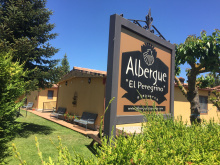
|
| Albergue INpulso Atapuerca 18€ 13 Booking.com |
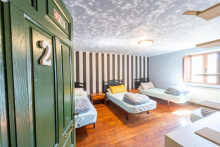
|
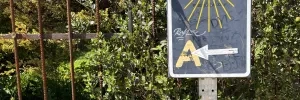
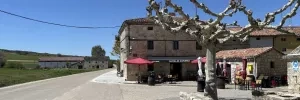
Accommodation in Cardeñuela Riopico.
| Albergue Santa Fe 10-12€ 15 |
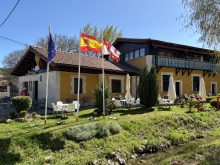
|
| Albergue municipal La Parada 8€ 12 |
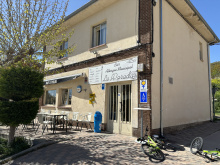
|
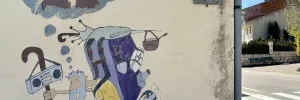
Neither of the two towns along the río Pico is remarkable for much. Pay attention when leaving the latter; shortly outside of town you will be faced with the first decision regarding how to enter Burgos.
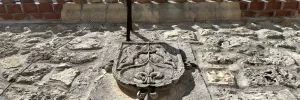
Less than 1km after leaving Orbaneja Ríopico the camino splits, offering two different ways to get to Burgos. Of the two, the River Route is the strong favorite but the yellow arrows come and go as local business vandalize the official markers in an attempt to divert traffic.
River Route, via Castañares - 11.3 km
Although the trail through Castañares is considered by some to be an alternative route, it offers a much more pleasent and fully signed way to the center of Burgos. There are a few tricks, since from Castañares there are also two trails, one along the road and one along the river. To begin your way to Castañares, follow these directions:
When leaving Orbaneja you will cross a bridge over the AP-1 (see map on previous page). A short distance afterward, at the junction leading to a housing development on your left hand side, turn left and follow the trail to Castañares. From Castañares you will have another choice between the road and a trail (see map below).
Read paragraph below, or inquire in the bar Peregrina T. Owners Cesar and Paloma will point you in the right direction. They speak English and are quite helpful.
Via Vilafría - 11.8 km
When leaving Orbaneja you will cross a bridge over the AP-1. A short distance afterward, at the junction leading to a housing development on your left hand side, continue straight for the road via Vilafría. This route will take you around the airport and is city walking along the sidewalk to the center of Burgos.
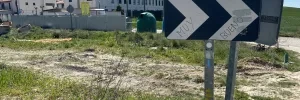
Finding the river route can be tricky!
From Castañares there are again two routes into Burgos, the Road Route and the River Route. The latter can be difficult to find because businesses repaint the yellow arrows on an almost daily basis. The most important part to remember is that the River Route does not leave Castañares along the busy road, see map.
To find it, cross the main road in Castañares near the bar Peregrina T. A short ways on you will find a small plaza and children’s play area with a fountain. Stay on that road, the Lugar de Barrio Castañares, towards a cement factory at its end.
From there turn right to pick up the trail again. It crosses a small bridge, parallels the A1 for a short distance (well separated from the road) before passing underneath it. At this point you can follow the trail, keeping the river on your right-hand side all the way into the center of Burgos. You will pass the circular Plaza de Toros and several bridges across the river. If you cross the river at the Puente de San Pablo you will be near the center of town and not far from the Municipal albergue.
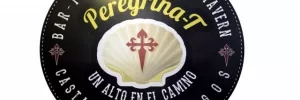
Finding the river route can be tricky!
From Castañares there are again two routes into Burgos, the Road Route and the River Route. The latter can be difficult to find because businesses repaint the yellow arrows on an almost daily basis. The most important part to remember is that the River Route does not leave Castañares along the busy road, see map.
To find it, cross the main road in Castañares near the bar Peregrina T. A short ways on you will find a small plaza and children’s play area with a fountain. Stay on that road, the Lugar de Barrio Castañares, towards a cement factory at its end.
From there turn right to pick up the trail again. It crosses a small bridge, parallels the A1 for a short distance (well separated from the road) before passing underneath it. At this point you can follow the trail, keeping the river on your right-hand side all the way into the center of Burgos. You will pass the circular Plaza de Toros and several bridges across the river. If you cross the river at the Puente de San Pablo you will be near the center of town and not far from the Municipal albergue.
Burgos is a city that brings history to life. For many pilgrims it is the first place on the Camino Francés that beckons a two-night stay; and rightly so, Burgos has a tremendous amount of museums, churches, one cathedral, a few monasteries, and a healthy (or not) number of bars and restaurants to keep you busy. The Calle San Lorenzo, off the Plaza Mayor, has several good options for tapas, and the Plaza Huerto del Rey has a few restaurants that lean towards a carnivorous diet.
On the not to miss list are the Catedral y Museo de Burgos in the very center of the city, and the Castillo de Burgos perched on the hillside overlooking the town.
The Museum of Human Evolution houses the artifacts from Atapuerca, and the Arco de Santa María (free visit) houses an exhibition hall.
The markings on southern entrance to the Plaza Mayor, with associated dates, indicated flood water levels.
Once at the far end of Burgos be wary of misleading signs (some quite official looking) that point the way to Villabilla. That town has been severed from camino traffic by the construction of a rail track and some efforts have been made to surreptitiously reconnect it.
Burgos was originally founded at the end of the 9th century in a bid to repopulate these northern plains. From the expulsions of the Muslims (around the end of the 11th century) it quickly became one of Castilla’s most important city. It was here that the Catholic Kings Isabel and Ferdinand welcomed home Christopher Columbus after his second voyage to the new world, and it was here where General Francisco Franco was publicly proclaimed as Generalísimo in 1936 and which would serve as the dictators base of operations until the end of the civil war.
Set along the wonderful río Arlanzon, the city was built with massive walls and even more massive gates. In spite of this, the territory of Burgos (but more to the point Castilla) was widely disputed. The seed for much of the fighting was the will of King Fernando-I, who although wise enough to rule over the northern regions, was not too clever in managing his estate. He chose to divide the north into three regions upon his death, with each region going to a different heir.
Alfonso VI received León, García received Galicia, Sancho II received Castilla, and his daughter Urraca received the city of Zamora.
More land disputes followed and in the end it was Alfonso that reigned over the whole territory and was crowned the emperor of the Iberian Peninsula. This was at the end of 11th century, and the wealth collected by Alfonso from tariffs throughout the peninsula was transformed into palaces and a Cathedral, catapulting Burgos into prosperity.
Burgos is also the home of El Cid, a fierce warrior, and cunning politician. He was banished from the city by King Alfonso for having forced him to take an oath attesting to his innocence in the death of his brother Sancho. El Cid would eventually turn down an invitation to return and fight for Alfonso, and instead traveled east to Valencia where he maneuvered himself into a kingdom of his own. He is now buried in the Cathedral.
With such a long history it should come as no surprise that the fiestas and festivals celebrated in Burgos range from solemn to spectacular. Among the more notable celebrations are the processions of Semana Santa (Holy Week), Corpus Christi (a moveable feast, celebrated on the Thursday after Trinity Sunday, which depends on Pentecost Sunday, which of course depends on Easter Sunday… the place to be is at the Monastery of Las Huelgas), and the festival of San Pedro and San Pablo (known together as Sampedros) in June.
Additionally, there are a number of more archaic events, some Moorish in origin and others pagan, that take place throughout the year. Burgos is a lively city.
The road out of Burgos is, thankfully, much shorter than the road in. The camino from here enters the meseta, with its endless plains of wheat. The landscape, while seemingly unremarkable, offers a wealth of flora and fauna and opportunities for peaceful contemplation. Do not underestimate it, for this is where the second third of the camino begins, the part of the camino which tones your mind (now that your body is strong).

There are a few bar/bakeries and a pharmacy on your right as you enter the town, the former serve up Torta de Aceite, a type of flatbread that is both delicious and unique to the area.
Passing through Tardajos, along the shortest path possible, the average pilgrim would be forgiven for overlooking its historical significance.
In fact, Tardajos lies at the intersection of the two primary and ancient trade routes that bisected this land. It was once a walled city and had three magnificent churches. Only one, the Iglesia de Santa María, remains.
Tardajos, like Rabé de las Calzada (ahead), also had a castle on a hill.
San Isidro (not to be confused with Isidoro) is celebrated on the 15th of May.
The camino departs from the main road in Tardajos and from here you won’t return to anything resembling a busy road until Frómista, do not be tempted to keep on the main road but rather cross the street and pass through the village.
Accommodation in Tardajos.
| Albergue La Fábrica 13€ 14 Booking.com |
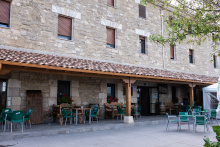
|
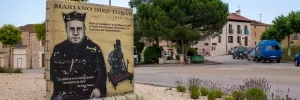
The camino has now entered the central Meseta, and the landscape here has had a lasting effect on the character of the people, but its lack of naturally durable building materials has meant the opposite for the architecture. Many of the treasures that once stood here are all but lost, the oldest remaining building is the 17th century palace house and village church.
The broad expanses here have a certain effect on the pilgrim psyche and to skip over it is to miss out on an important stage of the journey. Do not expect to see many of the places along the way until the last moment, they are often built into the shallow valleys where shade and water collects.
There is a fountain and a picnic area 2.4 km outside of Rabé de las Calzadas.
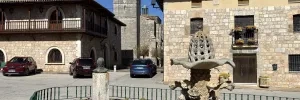
There is a pilgrim mass and benediction every day at 18:00. Hornillos is one of the best examples of a “Royal” camino road: in this case one long street (the aptly named calle real) stretched out along the camino. This layout allowed every building to face the camino, a trait which reminds us that the current heavy development along the camino is anything but a new phenomenon. The town once belonged to the monastery of St. Denis and was home to a Benedictine community.
Folklore places Charlemagne here too, baking bread for his troops along the river.
Ruins and medieval bridges are the only visible remains.
Accommodation in Hornillos del Camino.
| El Alfar de Rosalía 15€ 24 |
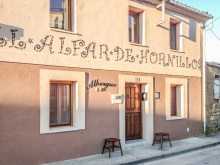
|
| La Casa del Abuelo | 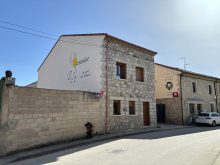
|

The spring that gives this arroyo (creek) its name, also cures your feet. The operations of the albergue here were passed to a nearby municipality, who electrified and modernized this former hippy hideaway.
The small deviation from the camino that takes you there is worth the shade and rejuvenating spring it provides.
Do not let the endless expanses of wheat worry you. Hontanas remains out of site until you are quite close, it is hiding in a small depression in an otherwise flat landscape.
Accommodation in Arroyo San Bol.
| Albergue Arroyo de San Bol 10€ 12 |
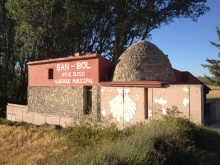
|
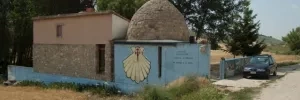
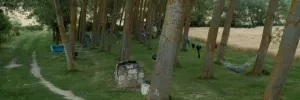
The town of Hontanas derives its name from the numerous natural springs, fontanas, that are to be found here.
These days the fountains still pour day and night, but it is the local pool which does most of the refreshing.
San Roque is celebrated on the 16th of August.
Accommodation in Hontanas.
| Mesón Albergue El Puntido 12€ 50 Booking.com |
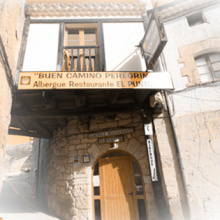
|
| Albergue Santa Brígida 15€ 42 Booking.com |
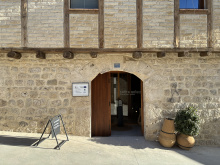
|
| Albergue Fuente Sidres 25*€ 17 |
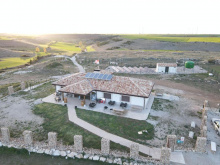
|
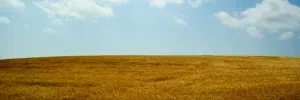
The ruins of the monastery and pilgrim hospital of San Antón is a delightful space that seems to embrace the camino, its archway spanning the road itself. Once a sprawling complex there is little that remains.
The albergue here has never seen better days, and the efforts of a dedicated team of volunteer hospitaleros keep the place as traditional as can be expected.
The niches in the archway, previously used by monks to deliver food to late arriving pilgrims, are now a popular spot to leave written messages.
Accommodation in San Antón - Ruinerne.
| Albergue de San Antón Donativo€ 12 |
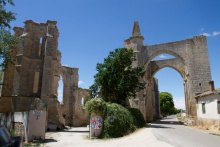
|
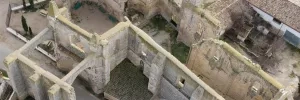
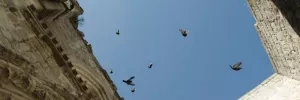
The camino follows the calle Oriente through Castrojeriz, a deceptively long journey. All three of its churches are worth a visit, and a hike to the ruins of the castle provide a view of the surrounding land that is paralleled only by the climb out of town.
Most pilgrim related services can be found along the calle Oriente, but the pharmacy and the larger groceries are closer to the main road.
Also along the Oriente is the Hospital del Alma; part art gallery and part meditation space and exactly where you want to go if you seek a bit a peace and quite.
In the main square is a small pilgrim shop, one of the last of its kind. The owner is quite a character and has managed to keep up with the times, trading the usual small village wares for the type of high-tech gear that modern pilgrims are looking for.
On the way out of town is the Bar Lagar, named for the well-preserved grape press sitting in the center. Check it out for a glimpse of how things were once done.
The houses along the road were built with an unseen secret, that of a tunnel which runs the length of the town and which connects the cellars. Apart from being the private property of the homeowners, its exploration is hampered by the construction of concrete dividing walls; a civil war era safety measure to preserve one’s well being. The town was, and still is, passionately divided. That won’t stop you from enjoying the charm it puts out for pilgrims.
San Juan is celebrated on the 24th of June. Other fiestas on the 25th and 26th of November for Santa Catalina.
The road ahead climbs up and over the Alto de Mostelares. There is not much shade to be had between here and the crossing into Palencia.
Accommodation in Castrojeriz.
| Albergue de San Esteban 7€ 30 |
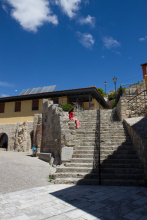
|
| Albergue and Camping de Castrojeriz 7€ 35 |
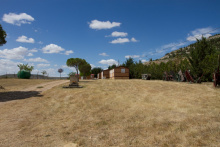
|
| Albergue Ultreia 14€ 26 |
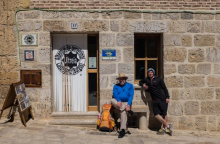
|
| Albergue Rosalía 15€ 32 Booking.com |
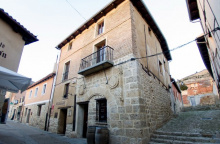
|
| Espacio Interior 20€ 6 |
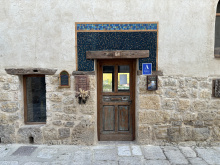
|
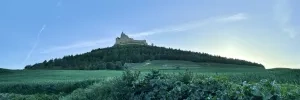
The Alto de Mostelares is the highest of the peaks you will encounter along the meseta, but it is not as difficult as it appears from Castrojeriz. From the top the view is more remarkable looking back towards where you came from. There is a shelter from the weather, but no water, at the top.
From the top the camino follows along a newly resurfaced stretch of the camino. Always downward, the descent is easy going after the first stretch which is quite steep indeed.
Between the Alto and the Ermita is a shaded picnic area.
The Ermita of San Nicolás, like the ruins of San Anton before Castrojeriz, has a long history of taking care of pilgrims. Both stand on their own far from towns and as a result, they don’t necessarily get the amount of traffic they deserve. Perhaps that is for the best as pilgrims often claim them to be the most memorable albergues along the way.
Just beyond the Ermita is the Puente Fitero which takes you over the river of the same name, and into Palencia.
Accommodation in Ermita de San Nicolás.
| Albergue de San Nicolas Donativo€ 12 |
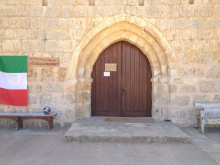
|



